©2022 Holobloc Inc. The contents of this document may be reused
under the
terms of the Creative
Commons Attribution 4.0 License,
provided that attribution is made to the URL
https://www.holobloc.com/papers/iec61499/overview.htm.
IEC 61499-1 defines an open architecture for distributed and embedded control and automation. In conjunction with an appropriate compliance profile as defined in IEC 61499-4 and software tools meeting the requirements of IEC 61499-2, reusable software modules (function blocks) can be developed and deployed in distributed systems that will meet the requirements of:
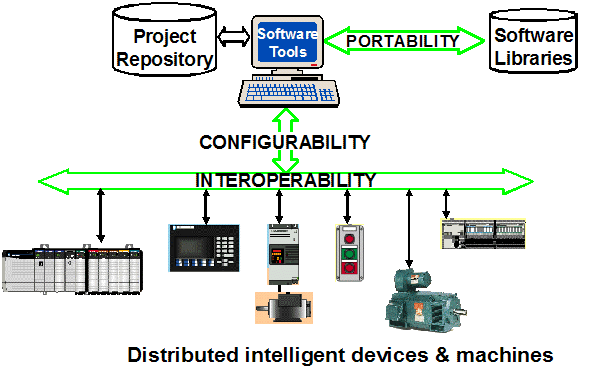
In the IEC 61499 standard, the basic unit for encapsulating and reusing Intellectual Property (IP="know-how") is the function block type. In object-oriented terms, this is a class defining the behavior of (possibly) multiple instances. It includes event inputs and outputs as well as the more traditional data inputs and outputs, to provide for synchronization between data transfer and program execution in distributed systems.
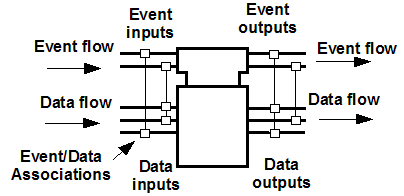
As its name implies, the basic function block type is the "atom" out of which higher-level "molecules" are constructed. With IEC 61499 compliant software tools, software developers can encapsulate, reuse and deploy IP in the form of algorithms written in the IEC 61131-3 programming languages, or other languages such as Java® or C++. Execution of these algorithms is triggered by Execution Control Charts (ECCs), which are event-driven state machines similar to the well-known Harel Statecharts.
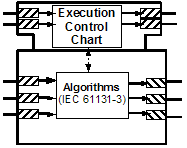
Another "atomic" function block type is the service interface function block (SIFB) type. This represents the interface to low-level services provided by the operating system or hardware of the embedded device, such as:
IEC 61499-compliant software tools and and their associated runtime packages provide a large selection of GUI and communications SIFBs. Providers of hardware SIFBs (typically the manufacturers of embedded devices) can use IEC 61499-compliant software tools to document how they work in the form of service sequence diagrams.

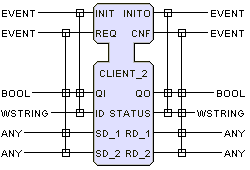
Software developers can use IEC 61499-compliant software tools to build higher-level function block "molecules" called composite function block types out of lower-level function block "atoms" ( component function blocks). This is done by specifying the event and data interfaces of the composite type, then filling it with a diagram showing how its internal component function blocks are connected. In this kind of function block, execution of the algorithms in the component function blocks is controlled by the flow of events from one component to another.

In the IEC 61499-1 architectural model, distributable applications are built by interconnecting instances of reusable function block types with appropriate event and data connections,in the same manner as designing a circuit board with integrated circuits. Using IEC 61499-compliant software tools, these function blocks can then be distributed to physical devices across a network, as long as these devices comply with the applicable compliance profile.

It is also possible to distribute an application across multiple resources within a device. Resources might be multiple processors plugged into a backplane, or multiple tasks within a single processor with a multitasking operating system. In the example shown below, pieces of Application A run in Resources x, y and z, as well as other devices in the system; pieces of Application B run in resource z and in other devices; and Application C runs "locally" in Resources x and y.

In the IEC 61499 architecture, resources are the workhorses that provide the services needed to integrate all the pieces of applications into a working distributed system. IEC 61499-compliant software tools can be used to:
In the example shown below:
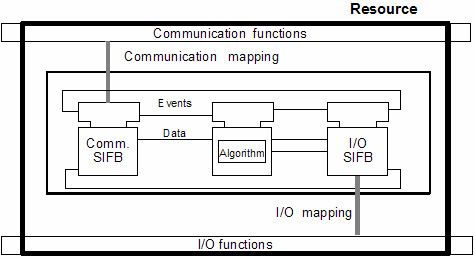
In the example shown below:
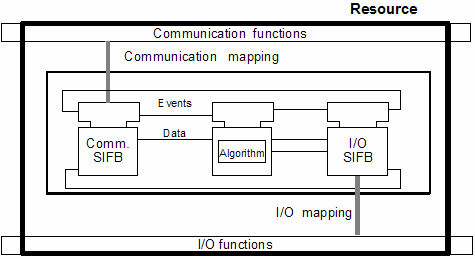
IEC 61499-compliant software tools can be used according to the following procedure to configure distributed control and automation systems from libraries of reusable IEC 61499-compliant components:
Following is a list of IEC 61499-related software tools known to the authors. Such tools should: (1) meet the requirements defined in IEC 61499-2, and (2) have their characteristics defined in a Compliance Profile as specified in IEC 61499-4 (The first two software tools listed below comply, for the most part, with the Compliance Profile for Feasibility Demonstrations).